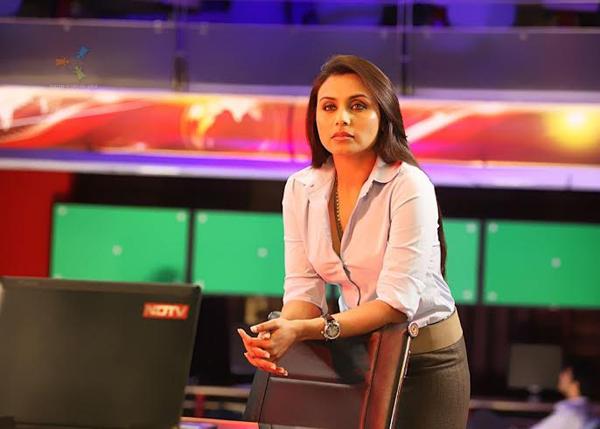 image
image
Talking heads
The hit movie Bajrangi Bhaijaan has an interesting character called Chand Nawab, a small time television reporter in Pakistan, who is not taken seriously by channel editors. But how members of the fourth estate are portrayed in Bollywood in general? Shoma A. Chatterji takes a look
In Bajrangi Bhaijaan for TV journalist Chand Nawab’s the big story becomes a mission instead -to help restore a little girl to her home by the hero overriding his personal dream of ‘breaking news’ and catch the attention of the important people who ignore him.
However, in most Bollywood films, journalists as a collective group are displayed in rather poor light. They rush in with their mikes and cameras to take a byte from everyone and anyone at the drop of a hat. It makes for a poor and derogatory representation of journalists on celluloid. The portrayal of the print media is confined to close-ups of sensational newspaper headlines and the bylines do not matter.
But if you wonder why members of the fourth estate do not protest collectively and straighten things out, there might be a grain of truth in some of the portrayals.
Take Peepli Live (2010), for example, where the media tries to sensationalise common men’s plight for the sake of the ‘first to break the news’. The subject deals with the prospective suicide of a young farmer whose family is so burdened by debts that only if one of the two brothers dies can the family be saved from collective death because the family will then get the one lakh rupee dole the government has promised. It is one of the most scathing critiques of journalism in contemporary India presented with an intelligent combination of sharp wit and crackling satire.
Peepli Live unmasks the underside of contemporary journalism in India, most of which is not pleasing to the eye. It focuses on a rather unsavoury aspect of the go-getters in the business who often sully the image of the media. .jpg)
One of the best and rare satires from the Bollywood factory, Kundan Shah’s Jaane Bhi Do Yaaron (1983), portrays the media and journalists in a grey light too. Shobha (Bhakti Barve) is a double-dealing lady editor of newspaperKhabardar which can mean either in Hindi, ‘danger’ or “do not dare.” She is ready to do anything to get a story that will raise the circulation of her paper including fake stories. Through hilarious situations, Shah weaves into the narrative a comment on the media, which often acts as holier- than- thou. That the film still catches eyeballs of the Y-generation who more busy with the internet, You-tube and blogs, is a proof of the many home truths about corruption in high places, including the media’s manipulations.
Then there are critically acclaimed films like New Delhi Times made in the 80s (directed by Romesh Sharma and written by Gulzar) where Shashi Kapoor plays a serious journalist who falls prey to a corrupt system and the nexus between politicians and media barons. The film had ran into trouble for its content though it went on to win National Awards later.
Later a Jeetendra starrer film titled New Delhi was also quite popular where the former Bollywood megastar plays a Delhi based journalist who was tortured and put in a mental asylum after exposing politicians shown as rapists.
In Tinnu Anand's Main Azaad Hoon (1989), Shabana Azmi plays a journalist who begins to write a column about a fictitious do-gooder she names “Azaad” because she anticipates getting fired by the new editor.
The column becomes famous and the circulation jumps so readers want to see Azaad in flesh-and-blood. She then must find a man who would fit into the image of Azaad. She chances upon a tramp from nowhere and coerces him into role-playing. The film offers an unusual take on journalism. The columnist Suhasini has no clue that the editor (Manohar Singh) is using her and Azaad to become the dictatorial PM one day.
Madhur Bhandarkar’s Page 3 (2005) is an excellent example of this scenario – the good, bad and the ugly. One reason could be that from a print media which dominated the scene till well into the late 1980s, the journalist in Bollywood is today largely a TV talking head. With mushrooming channels (many reportedly suffering huge losses) the competition to get there first often means throwing ethical standards to the wind.
Although there are many current issues affecting the industry, such as the struggle between print and online media, few films have shed realistic light on journalists and the profession.
Madras Café (2013) directed by Shoojit Sircar is a more realistic portrayal of the profession. It is perhaps the only film in recent times to feature a war correspondent. The film is set in the late 1980s and early '90s, during the Indian intervention in the Sri Lankan civil war followed by the assassination of then-PM, Rajiv Gandhi.
.jpg) Major Vikram Singh (John Abraham) is an Indian Army Special Officer appointed by RAW to head covert operations in Jaffna shortly following the Indian peace-keeping force’s forced withdrawal from the city. During his investigation, he meets Jaya Sahni (Nargis Fakhri), a London-based British war correspondent, who wants to investigate the truth about the civil war. The two uncover a conspiracy to assassinate ‘a former Indian prime minister’. Jaya is a no-nonsense, committed war correspondent assigned to cover the Sri Lankan civil disturbances. As she joins in the investigation where Vikram has disguised himself as a journalist, there is a sharing of views but no romance, thankfully, rather admiration between two professionals for each other.
Major Vikram Singh (John Abraham) is an Indian Army Special Officer appointed by RAW to head covert operations in Jaffna shortly following the Indian peace-keeping force’s forced withdrawal from the city. During his investigation, he meets Jaya Sahni (Nargis Fakhri), a London-based British war correspondent, who wants to investigate the truth about the civil war. The two uncover a conspiracy to assassinate ‘a former Indian prime minister’. Jaya is a no-nonsense, committed war correspondent assigned to cover the Sri Lankan civil disturbances. As she joins in the investigation where Vikram has disguised himself as a journalist, there is a sharing of views but no romance, thankfully, rather admiration between two professionals for each other.
No One Killed Jessica (2011) adapted from the true story of the brutal murder of Jessica Lal in a Delhi bar demonstrates the brassy reality of a television anchor played with hard-hitting sharpness by Rani Mukherjee.
One can observe that in recent years on celluloid stories from Bollywood at least, the poorly paid, ill-dressed, paan-chewing jholawalla hack has morphed into a slick, loud-mouthed, man or woman, some of them even belonging to the ‘system’ , in keeping with the changing morals of real life ideology.
The media plays an important role of functioning as a communication line with the masses. The ideas presented in journalism films reach a mass audience and can influence viewers’ perception of the media to some degree. The media is constantly evolving, and as the industry continues to change, so too will perhaps the image of journalists in film.
Top Headlines
-
Entertainment
Valentyn Vasyanovychs To The Victory! wins 2025 TIFF Platform Award unanimously
September 26, 2025
-
Entertainment
Chlo Zhaos Hamnet Wins TIFF 2025 Peoples Choice Award
September 20, 2025
-
Entertainment
Sholay: Golden even after fifty years
July 04, 2025
-
Entertainment
War 2: Check out Hrithik Roshan, Jr NTR and Kiara Advani's new posters
June 26, 2025
-
Entertainment
LGBTQIA+: Icelandic film Odd Fish and Brazil's Baby win big at KASHISH 2025 film festival
June 12, 2025
-
Entertainment
Katrina Kaif named Maldives tourism global brand ambassador ahead of Modi's visit
June 10, 2025
-
Entertainment
'Queen marches to conquer': Deepika Padukone joins Atlee's AA22xA6 starring Allu Arjun after 'Spirit' exit
June 08, 2025
-
Entertainment
Dakota Johnson and Chris Martin, who were in on-and-off relationship, broke up: Reports
June 06, 2025
-
Entertainment
Sharmila Tagore to Alia Bhatt, India weaves cross-generational tale at Cannes 2025
May 28, 2025
-
Entertainment
Is Sandeep Reddy Vanga's cryptic 'feminism' post meant for Deepika Padukone? Neitzens think so
May 27, 2025


